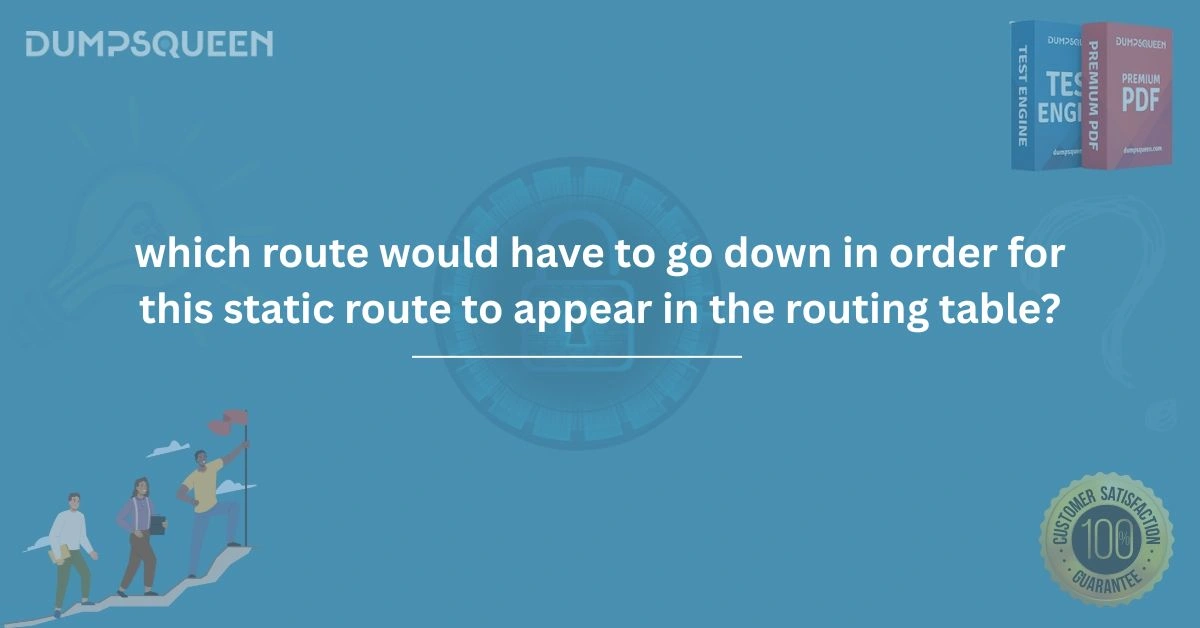Introduction
In the vast and intricate world of networking, routing forms the heart of how data travels between devices across networks. Every routing decision made by a device is critical to the delivery of packets, and ensuring high availability requires both dynamic and static routes to function together properly. For aspiring network engineers and IT professionals preparing for certifications such as Cisco CCNA 200-301, understanding how static routes behave is essential especially in the context of when and in which route would have to go down in order for this static route to appear in the routing table. This question isn’t just a theoretical one. It appears in network design, failover planning, and even in certification exam simulations. In this comprehensive article by DumpsQueen, we dive deep into the mechanism that governs how static routes are inserted into the routing table, the conditions under which they do not appear, and what needs to fail in order for them to take precedence. Let’s explore this topic through a practical, conceptual, and exam-relevant lens.
Understanding Static Routes and the Routing Table
A static route is a manually configured route that tells a router how to reach a specific destination. Unlike dynamic routing protocols such as OSPF, EIGRP, or RIP that learn routes automatically, static routes require human configuration. They offer control, predictability, and are often used in smaller networks, or in situations where deterministic routing is critical. The routing table is a database that contains the best possible paths to different destinations. When a router receives a packet, it consults the routing table to determine where to send it next. But just because a static route is configured doesn't mean it will automatically appear in the routing table. There are certain prerequisites that need to be met. The core question in which route would have to go down in order for this static route to appear in the routing table? refers to this behavior. In simple terms, if another route with better metrics or priority already exists for the same destination, the static route might not be used unless the primary route fails.
Administrative Distance: The Deciding Factor
To understand this concept thoroughly, we must first understand administrative distance (AD). Administrative distance is a measure of trustworthiness or preference assigned to routes discovered or configured on a router. Lower administrative distances are preferred over higher ones.
For example:
-
Directly connected routes have an AD of 0
-
Static routes have an AD of 1 (or higher if manually configured)
-
OSPF routes have an AD of 110
-
RIP routes have an AD of 120
So, if a router learns the same route to a destination via both a dynamic protocol like OSPF (AD 110) and a static route (AD 1), the static route will be preferred unless it points to a next-hop that is not reachable.However, if the static route is configured with a higher administrative distance than the dynamic route, it acts as a backup or floating static route. It will only be used when the preferred route (with lower AD) goes down. Thus, in which route would have to go down in order for this static route to appear in the routing table? The answer lies in this logic: the route that is currently preferred (lower AD) would have to fail for the static route to be installed and used.
Floating Static Routes and Failover Planning
A floating static route is a static route that is intentionally given a higher administrative distance so that it can act as a backup in case the primary route fails. It "floats" in the background, waiting to be used when necessary.
Consider the following scenario:
-
You have a network 192.168.10.0/24
-
It is reachable via OSPF (AD 110)
-
You also configure a static route:
ip route 192.168.10.0 255.255.255.0 10.1.1.2 150
This static route has an AD of 150, meaning it won't be used while OSPF is functioning correctly. But if OSPF fails i.e., the OSPF-learned route goes down, then the static route will appear in the routing table and take over. So, in which route would have to go down in order for this static route to appear in the routing table? the OSPF-learned route (the primary one). This concept is frequently tested in certification exams, lab simulations, and real-world redundancy designs.
Routing Table Selection Process
To fully grasp the mechanism, let's walk through the routing table selection process:
-
The router receives multiple route advertisements for the same destination.
-
It compares the administrative distances.
-
The route with the lowest administrative distance is preferred.
-
If that route becomes unavailable (due to link failure, protocol shutdown, or neighbor timeout), the router removes it from the routing table.
-
At that moment, if there is a floating static route configured with a reachable next-hop, it is inserted into the routing table.
-
Traffic now flows through the backup route.
Understanding this sequence is critical to answering the keyword question accurately.
Practical Example in Network Design
Let’s consider a more complex real-world example. Imagine a company with two ISPs. The primary ISP is connected via OSPF, and the secondary is through a manually defined static route. In such a setup, the static route serves as a backup. You configure the static route like this: ip route 0.0.0.0 0.0.0.0 203.0.113.2 250 While OSPF is up and running, this static route won’t be used because its AD (250) is higher than OSPF’s (110). However, when the OSPF connection goes down (e.g., due to ISP failure), the router checks if an alternative path is available. Finding the static route valid, it installs it into the routing table. So, in which route would have to go down in order for this static route to appear in the routing table? The answer again is: the OSPF-learned default route would have to go down.
Common Troubleshooting Scenarios
In troubleshooting scenarios, engineers often overlook administrative distance settings. When a static route doesn’t show up in the routing table, it's usually because:
-
Another route with a better (lower) AD exists
-
The next-hop IP in the static route is not reachable
-
The interface in the static route is down
Identifying which route has to fail is crucial to activating the desired fallback path.
Relevance to Certification Exams
For students preparing for certifications like Cisco CCNA 200-301, understanding static routing behavior is not optional it’s mandatory. The exam often includes questions and simulations based on route failover and administrative distances. DumpsQueen offers updated dumps, practice questions, and detailed study guides for CCNA and other networking exams. Our materials include real-exam scenarios like the one covered in this article, helping candidates gain a deep conceptual understanding. This keyword “in which route would have to go down in order for this static route to appear in the routing table?” closely mirrors the wording of certification exam questions. It tests logical reasoning and technical configuration knowledge.
Free Sample Questions
1. Which routing feature allows a static route to act as a backup path only when the primary path fails?
A. Equal-cost load balancing
B. Floating static route
C. Policy-based routing
D. Default routing
Correct Answer: B. Floating static route
2. A static route has an administrative distance of 150. An OSPF-learned route exists for the same destination. What must happen for the static route to be used?
A. OSPF must increase its AD
B. The static route must be deleted and re-added
C. The OSPF route must go down
D. The router must reboot
Correct Answer: C. The OSPF route must go down
3. What is the default administrative distance of a manually configured static route (without specifying AD)?
A. 0
B. 1
C. 110
D. 120
Correct Answer: B. 1
4. You configured a static route, but it is not visible in the routing table. What is the likely cause?
A. Static routes never show in the routing table
B. The dynamic route has a higher AD
C. The static route has a higher AD than an existing route
D. Static routes require DHCP to be active
Correct Answer: C. The static route has a higher AD than an existing route
Conclusion
Routing is more than just forwarding packets it's about intelligently managing network paths based on priority, availability, and configuration logic. Static routes are reliable and straightforward, but they don't always take precedence. If you're ever asked in which route would have to go down in order for this static route to appear in the routing table?, remember the role of administrative distance, route availability, and failover design. Understanding this concept can not only help you in passing certification exams like Cisco CCNA (for which DumpsQueen provides comprehensive dumps and resources), but also in architecting real-world networks that are resilient and efficient. Stay ahead in your certification journey with DumpsQueen your trusted partner in IT exam success.



